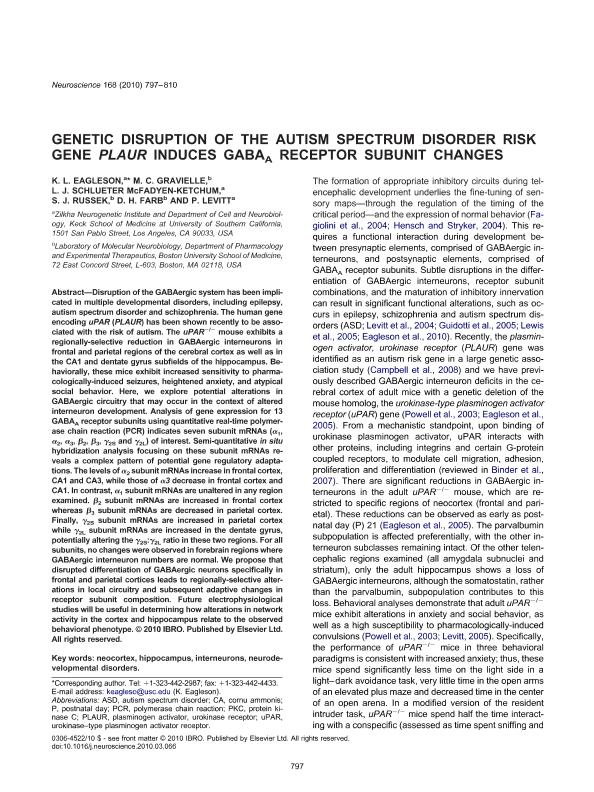Artículo
Genetic disruption of the autism spectrum disorder risk gene PLAUR induces GABAA receptor subunit changes
Eagleson, K. L.; Gravielle, Maria Clara ; Schlueter McFadyen Ketchum, L. J.; Russek, S. J.; Farb, D. H.; Levitt, P.
; Schlueter McFadyen Ketchum, L. J.; Russek, S. J.; Farb, D. H.; Levitt, P.
 ; Schlueter McFadyen Ketchum, L. J.; Russek, S. J.; Farb, D. H.; Levitt, P.
; Schlueter McFadyen Ketchum, L. J.; Russek, S. J.; Farb, D. H.; Levitt, P.
Fecha de publicación:
07/2010
Editorial:
Pergamon-Elsevier Science Ltd
Revista:
Neuroscience
ISSN:
0306-4522
Idioma:
Inglés
Tipo de recurso:
Artículo publicado
Clasificación temática:
Resumen
Disruption of the GABAergic system has been implicated in multiple developmental disorders, including epilepsy, autism spectrum disorder and schizophrenia. The human gene encoding uPAR (PLAUR) has been shown recently to be associated with the risk of autism. The uPAR-/- mouse exhibits a regionally-selective reduction in GABAergic interneurons in frontal and parietal regions of the cerebral cortex as well as in the CA1 and dentate gyrus subfields of the hippocampus. Behaviorally, these mice exhibit increased sensitivity to pharmacologically-induced seizures, heightened anxiety, and atypical social behavior. Here, we explore potential alterations in GABAergic circuitry that may occur in the context of altered interneuron development. Analysis of gene expression for 13 GABAA receptor subunits using quantitative real-time polymerase chain reaction (PCR) indicates seven subunit mRNAs (α1, α2, α3, β2, β3, γ2S and γ2L) of interest. Semi-quantitative in situ hybridization analysis focusing on these subunit mRNAs reveals a complex pattern of potential gene regulatory adaptations. The levels of α2 subunit mRNAs increase in frontal cortex, CA1 and CA3, while those of α3 decrease in frontal cortex and CA1. In contrast, α1 subunit mRNAs are unaltered in any region examined. β2 subunit mRNAs are increased in frontal cortex whereas β3 subunit mRNAs are decreased in parietal cortex. Finally, γ2S subunit mRNAs are increased in parietal cortex while γ2L subunit mRNAs are increased in the dentate gyrus, potentially altering the γ2S:γ2L ratio in these two regions. For all subunits, no changes were observed in forebrain regions where GABAergic interneuron numbers are normal. We propose that disrupted differentiation of GABAergic neurons specifically in frontal and parietal cortices leads to regionally-selective alterations in local circuitry and subsequent adaptive changes in receptor subunit composition. Future electrophysiological studies will be useful in determining how alterations in network activity in the cortex and hippocampus relate to the observed behavioral phenotype.
Palabras clave:
Hippocampus
,
Interneurons
,
Neocortex
,
Neurodevelopmental Disorders
Archivos asociados
Licencia
Identificadores
Colecciones
Articulos(ININFA)
Articulos de INST.DE INVEST.FARMACOLOGICAS (I)
Articulos de INST.DE INVEST.FARMACOLOGICAS (I)
Citación
Eagleson, K. L.; Gravielle, Maria Clara; Schlueter McFadyen Ketchum, L. J.; Russek, S. J.; Farb, D. H.; et al.; Genetic disruption of the autism spectrum disorder risk gene PLAUR induces GABAA receptor subunit changes; Pergamon-Elsevier Science Ltd; Neuroscience; 168; 3; 7-2010; 797-810
Compartir
Altmétricas



